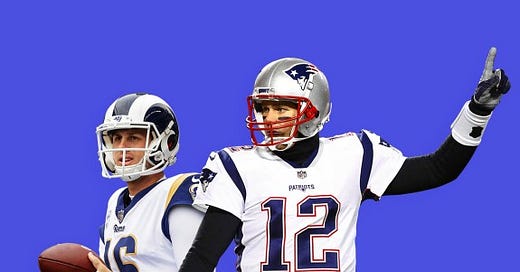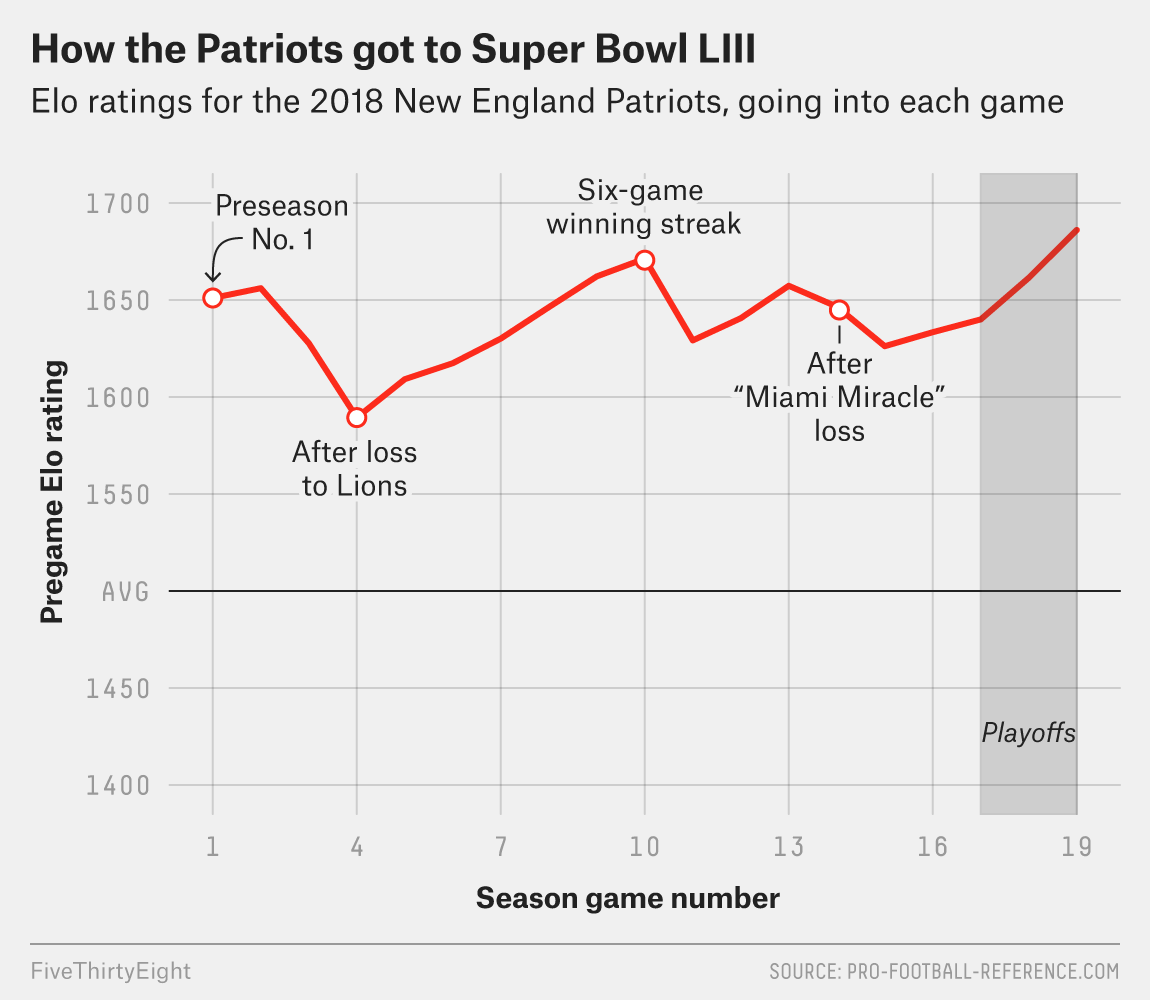The Rams And Patriots Have Reversed Roles Since Their First Super Bowl Meeting
One of the most wonderfully ironic moments in Super Bowl history happened just before kickoff in February 2002, when St. Louis Rams wide receiver Ricky Proehl turned to NFL Films’ cameras during warmups and declared: “Tonight, a dynasty is born!”
Proehl was right, of course. A dynasty was born that night — just not the one he was imagining. Tom Brady and the New England Patriots ended up toppling the heavily favored Rams in Super Bowl XXXVI, using it as a springboard for the greatest run of sustained success any NFL team has ever known.
The Patriots were the up-and-coming team back then, while the Rams were the established champions with the veteran, future Hall of Fame quarterback. This time around, though, the roles will be reversed for the two franchises — with the Patriots serving as the elder statesmen, while the Rams are the team on the rise. It’s a fitting turnabout, one featuring what the Elias Sports Bureau determined was the largest gap in age between both starting quarterbacks (Tom Brady is 17 years and 72 days older than Jared Goff) and head coaches (Bill Belichick is 33 years and 283 days older than Sean McVay) in Super Bowl history.
The Rams opened the betting Sunday night as slight favorites with some sportsbooks (so yes, you can say you were an underdog, Tom), though that didn’t last long. A flood of bets for the Patriots pushed the line to favor New England by 2½ points, according to the current consensus in Vegas. Here’s what our Elo ratings think about the matchup, using both the classic version from our interactive and one with the experimental quarterback adjustments we’ve been tinkering with:
The Patriots still somehow have two very important components from that original Super Bowl against the Rams: Brady and Belichick. At age 41, Brady had his worst passing numbers in several years, yet he also was still a top-10 QB (at worst), a Pro Bowler and — it bears emphasizing — impossibly productive for his age. All of that came despite throwing to a revolving-door cast of receivers and a less-dominant version of longtime security blanket Rob Gronkowski. All told, Brady led an offense that still ranked fourth in scoring and eighth in expected points added, albeit with a lower per-game EPA average than any Pats team with Brady as starter since 2013.
For Belichick’s part, this season saw his Patriots improve significantly on defense, jumping from 24th in EPA in 2017 to seventh in 2018. Although New England tied for the second-fewest sacks in the league, it generated the third-most pressure (according to ESPN’s Stats & Information Group), forced the second-lowest completion percentage and generally was the best Patriots pass defense in a while. And this team was also a celebration of Belichick the (de facto) general manager: In addition to shrewd veteran acquisitions such as CB Stephon Gilmore and LB Kyle Van Noy, a large share of the Pats’ production came from draft picks made over the past few years, including DLs Trey Flowers and Malcom Brown, OLs Shaq Mason and Joe Thuney, and rookie RB Sony Michel.1 All of those pickups helped fuel a Pats roster that still relied heavily on Brady to work his magic but also blocked well and played sound defense.
The Patriots’ run wasn’t always easy, of course. The 2018 edition had the second-worst points per game differential and lowest Elo rating of the franchise’s Super Bowl-bound squads since … you guessed it, the 2001 team. But maybe that’s just further proof that everything truly has come full circle in New England. They’re certainly hoping the story ends the same way this time around.
As for these current Rams, they are not too dissimilar from their Greatest Show on Turf forebears, either. Los Angeles outscored opponents by 143 total points in the regular season (third-best in football) and got high marks in every power ranking out there, including Elo (which ranks them No. 2), Football Outsiders’ Defense-adjusted Value Over Average (No. 2), ProFootballFocus’s rankings (No. 2), Jeff Sagarin’s ratings (No. 2), Andy Dolphin’s predictive rating (No. 3) and Pro-Football-Reference.com’s Simple Rating System (No. 3). Though they never actually ranked first in Elo at any point during the season, the Rams were consistently one of the game’s top contenders all year long.
And they got that way just about as quickly as those fabled 1999 Rams, who went 4-12 the year before Kurt Warner and Marshall Faulk changed the franchise’s fortunes forever. The 2018 season culminated a remarkable two-year turnaround arc under soon-to-be-33-year-old coach Sean McVay, who took L.A. from a 4-12 disaster in 2016 under former coach Jeff Fisher to an 11-5 record last year, and now a Super Bowl. Over that span, the Rams went from an Elo rating of 1346 to 1667, a gain of 321 Elo points. Only four other Super Bowl teams in history have gained more rating points from the end of two seasons prior to the start of the big game itself — the 1998 Atlanta Falcons (+368), 1981 San Francisco 49ers (+360), 1992 Dallas Cowboys (+357) and 1971 Miami Dolphins (+339). Even the ’99 Rams had “only” gained 246 points of Elo from the end of 1997, though they do own the largest single-season gain ever for a Super Bowl team.
How did L.A. do it? The cornerstones of the 2018 team — Goff, DT Aaron Donald and RB Todd Gurley2 — were all drafted by the club from 2014 to 2016. But general manager Les Snead did his best work over the 2017 and 2018 offseasons, snagging the majority of the current team’s other starters either via the draft or in a flurry of win-now moves that mostly look smart in hindsight. The other key ingredient was coaching, where (with a few weird exceptions on Sunday) McVay has shown a fantastic knack for incorporating analytical thinking into his play-calling, and he remains the master of keeping defenses off-balance by running almost all of his plays out of the same personnel package. While there are very legitimate questions as to whether Goff or Gurley could be as successful in a different system, the pair has powered a Super Bowl run under McVay’s scheme.
Each team needed luck to get here, too. The Rams likely wouldn’t be headed to Atlanta without a blown pass-interference call that kept New Orleans from running down most of the clock in regulation, instead giving L.A. the chance to force overtime and eventually win the game. The Patriots benefited from a phantom roughing-the-passer penalty and a (legitimate) offside call that negated what would have been a game-ending interception, then rattled off what felt like a million straight third-and-long conversions in overtime. But there isn’t a single Super Bowl team in history that didn’t have big moments when fortune smiled on it. You have to be lucky and good to win a championship, and these teams fit both criteria.
Now, they’ll get a chance to battle on the game’s biggest stage. Will a new dynasty be born? Or will an old one keep rolling? Will the new Greatest Show on Turf avenge the old one? Or will Belichick draw up another brilliant game plan to shut down this latest version? Either way, it should be a fitting way to end one of the most entertaining NFL seasons in a while.
Filed under: NFL
Undrafted free agent C David Andrews should probably fit into this group as well.
Well, during the regular season, at least. Gurley has been something of a nonfactor in the playoffs, particularly against the Saints in the NFC title game.









